- Price: $19.99 USD
- Developer: TNgineers
- Publisher: Whitethorn Games
- Release Date: July 7, 2022
A review code was kindly provided by UberStrategist PR on behalf of TNgineers and Whitethorn Games. We thank them for being able to cover something they’ve worked so hard on.
You may be wondering about the origin of the name APICO. Apiculture is another word for beekeeping. An apiarist is a beekeeper, and an apiary is “a place in which a colony or colonies of bees are kept, as a stand or shed for beehives or a bee house containing a number of beehives.” (And apis is the Latin word for bee.)
APICO allows you to help #SaveTheBees in the game as well as in the real world – the website indicates that they will donate a portion of the proceeds to bee-related charities! 🐝 I sure hope that helps them generate a lot of…buzz…for those charities and their game! 😉
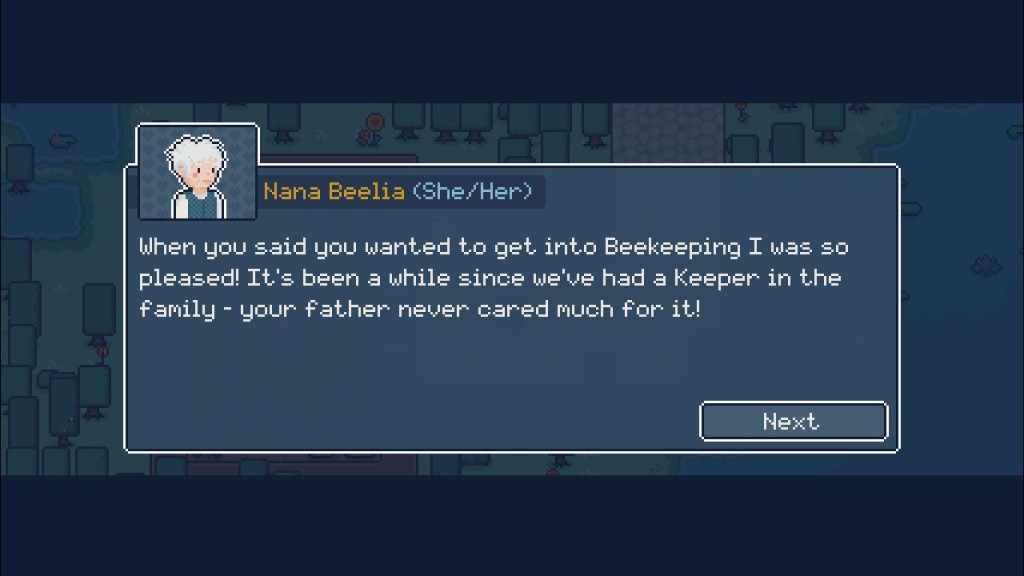
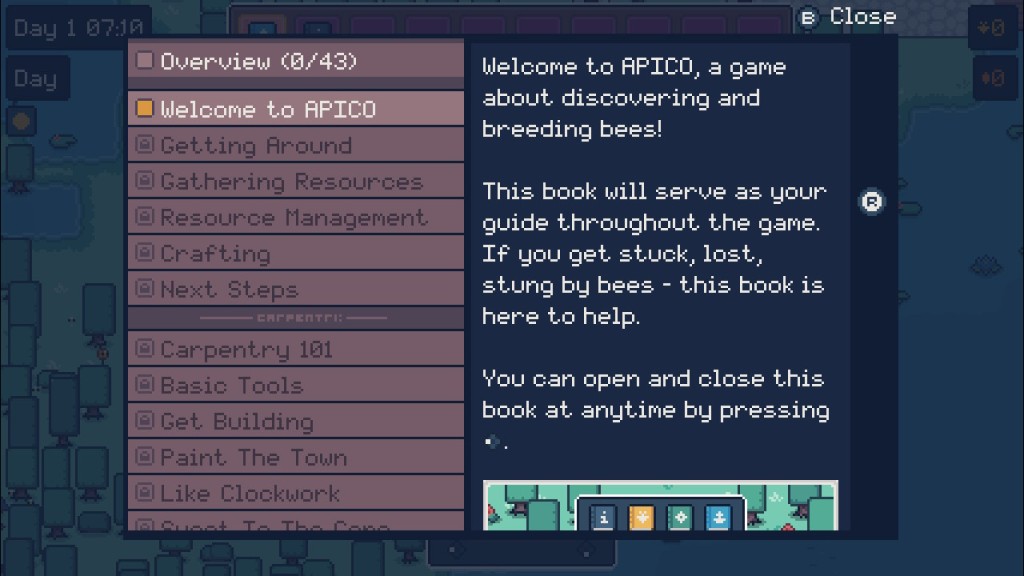
Once you’ve started the game and decided on your appearance, your character will arrive in Port APICO to continue the family tradition of beekeeping. Apparently your father wasn’t terribly interested in the occupation, and now that your grandfather has passed you’ll need to rely on his beekeeping guide to get started. The guide is pretty detailed, with over 40 illustrated “chapters”/tutorials to complete; you’ll receive rewards for completing each one. I was impressed by the way that the game guides you step by step.
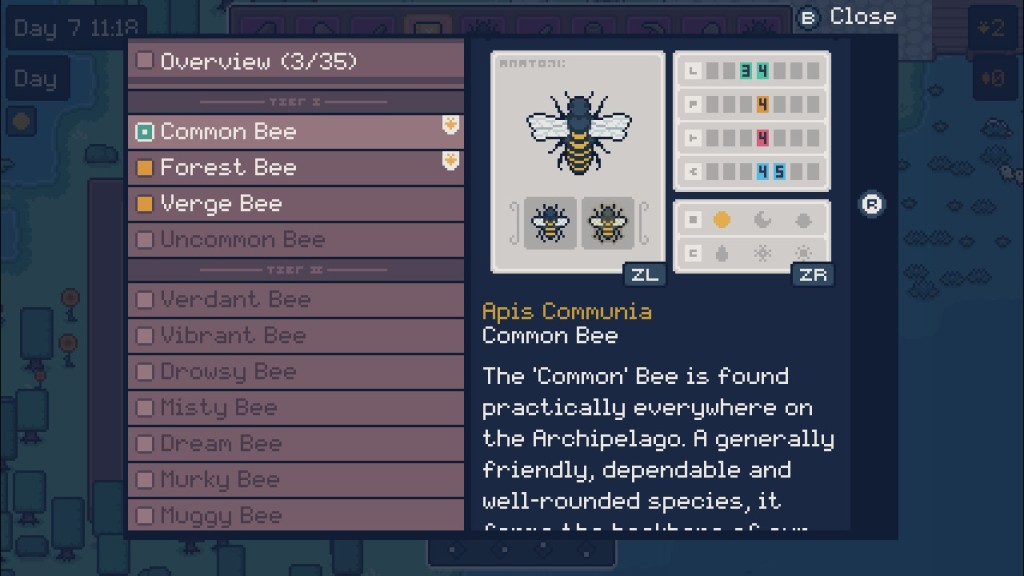
At first, you’ll only have about three species of bees available. There are nearly forty bee species in the game (as opposed to the ~20,000 known species in the world, with 4,000 of them being native to the United States 😮). To fill in the blank entries and acquire more bees, you’ll need to crossbreed the bees you have available or find more in the new areas you explore. The Encyclobeedia will provide you with hints about how to get the species you haven’t discovered yet, and Dr. Beenjamin BhD will help clear things up for you as well.
You can breed bees in hives by combining two of them into a single queen, and once you’ve started using the workbench you can craft apiaries to crossbreed new species of bees. There are two specific species that must be used for most crossbreeds, with no substitutions. Bees will have their own lifespan, productivity, fertility, and stability stats. Some species will have tougher conditions for them to appear from cross-breeding, which may include having the maximum lifespan stat or finishing the queen’s lifecycle in the rain. Additionally, individual bees – regardless of species – will only be active at a specific time of day, and they will not continue their activity until that timeframe comes around again.
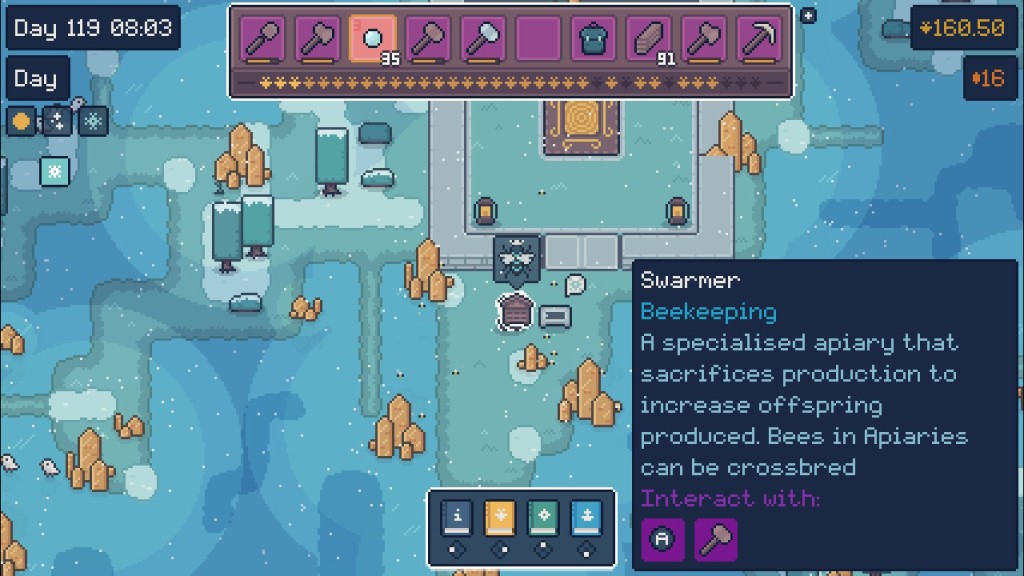
You can breed tolerances for different timeframes and weather into bees. Regarding weather conditions, some bees can tolerate the rain or snow, but others will become inactive in those conditions. You can save up and buy a heater and cooler to compensate for any temperature issues, and flowers can be placed in smokers to placate any angry bees.
It did take me a while to figure out how to properly manipulate weather conditions with blessings, as well as the mechanics for speeding up time to have bee-breeding finish in the required timeframe for the crossbred bees to form. At first, I also didn’t realize that some species needed to be combined in a specific environment like the swamp in order to get the new species I wanted.
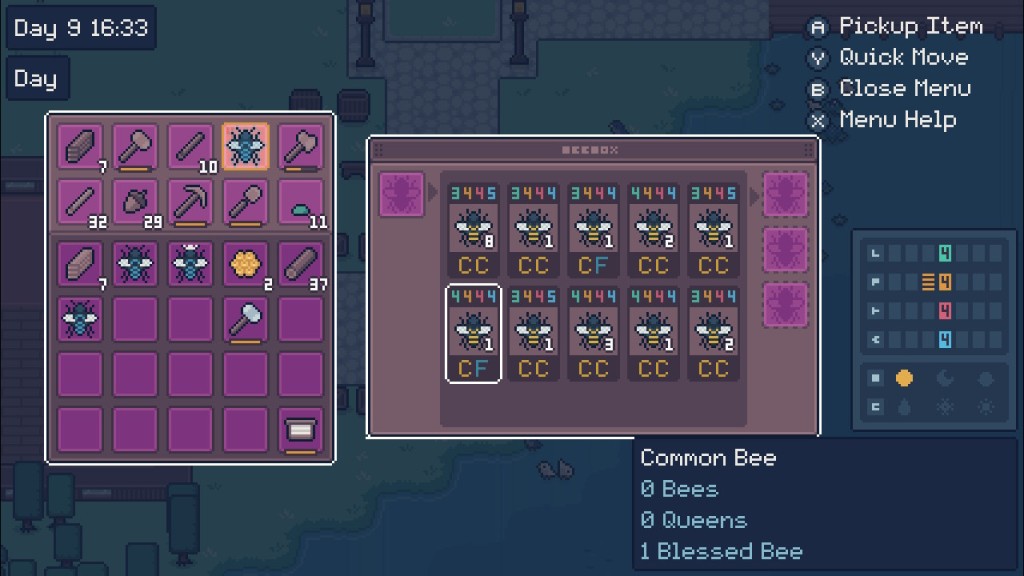
Anyways, as the main objective is bee conservation/restoration, you’re going to end up with a lot of bees in your attempts to crossbreed and discover new species. You can craft storage crates, but that’s not very practical when you’re going to have so many bees to store. That’s where bee boxes – which store unlimited amounts of each species – come in. Bee boxes only allow you to store one species there, but you can still store hybrid bees inside of them if the name in front is the same. (Common-Verge could be stored in the Common Bee Box, but not the Verge Bee Box, for example.)
I liked being able to store unlimited amounts of bees, but it did get a little chaotic trying to remember where I placed each box for individual species. There is a Beebank item for 999 currency that can store every species together, but it’s from a merchant who rarely appears (and it’s already hard enough to earn money). I did think that the inventory/storage systems were oddly designed. You start with a bag to carry things around, but instead of simply upgrading it or buying a larger bag, you have to buy another bag to put inside of your original bag.
Another issue I had was that some items (like flowers) could be stacked together, but items like frames and canisters could only be stored individually – even if they were empty. This resulted in a lot of wasted space. It also seemed like I couldn’t separate grouped items easily; I think I only managed to separate a stack once or twice but I have no idea how I did it. Things could get a bit cluttered both in storage and in the many menus on screen.
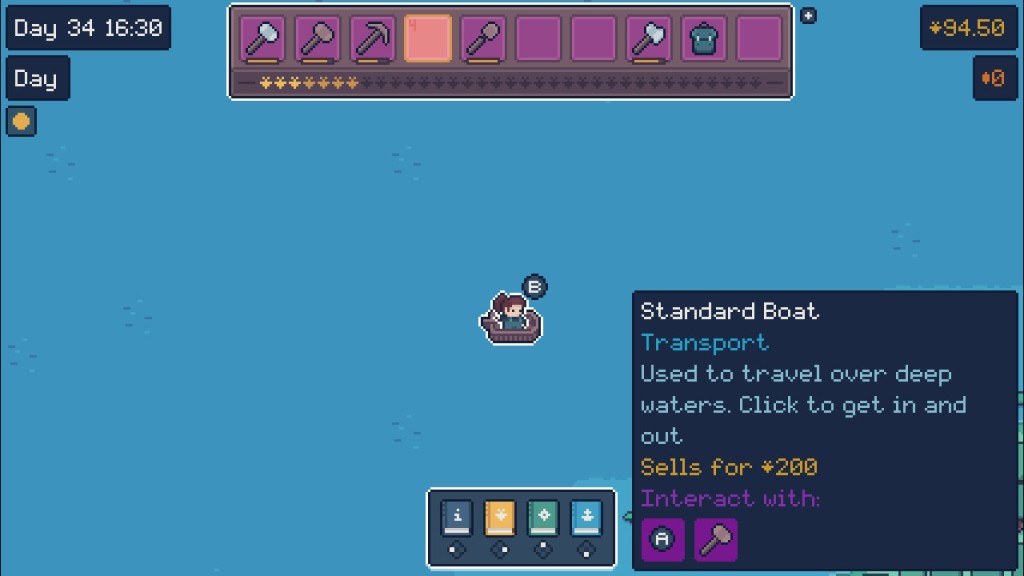
Once you reach a certain point, you can get a boat to travel to different biomes, such as the swamp or tundra. These areas have even more bees and flowers to gather, and again storage may be an issue. That’s where an updated version of the boat, the cargo boat, can come in handy. As the name would imply, the cargo boat has a cargo hold to store additional items you may need when you travel around. Unfortunately I found it a bit pricey and saved my money for additional smokers, so my inventory capacity remained somewhat limited. I did really like how each location wasn’t too far away from Port APICO, so it didn’t take very long to get to and from each area. And there are teleportation gates that allow you to fast travel without using your boat, which was very convenient.
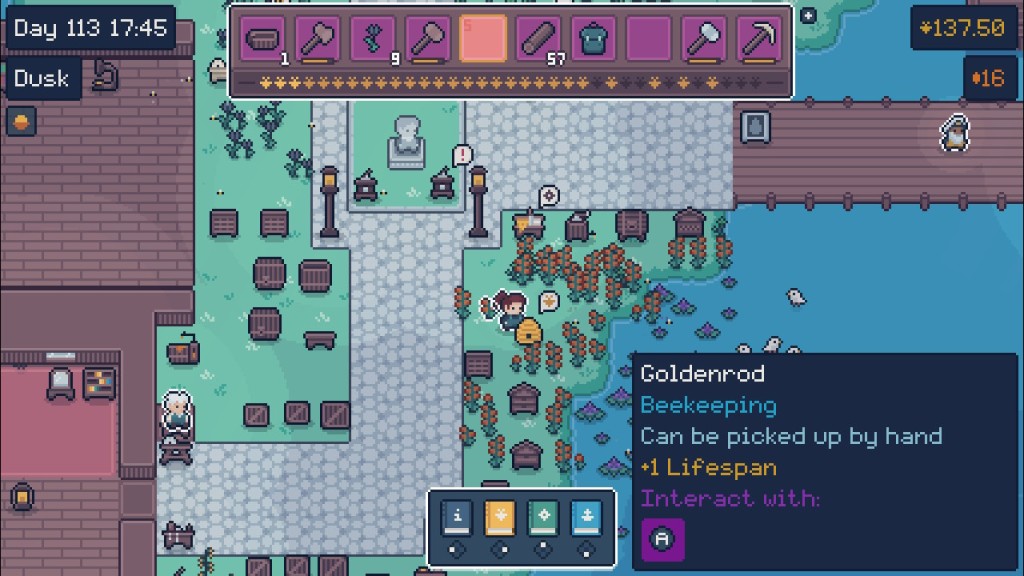
In addition to apiculture, you’ll also deal with floriculture to obtain materials for the aforementioned smokers. Like the bees, you start out with a certain amount of flowers. When you put some around the apiaries, the bees will cross-pollinate, and when they create byproducts you may get new flower seeds. Some flowers will increase or decrease bees’ stats, so you’ll have to place them strategically when crossbreeding. (Thankfully, you can uproot flowers once they’re grown and replant them elsewhere when you want to.)
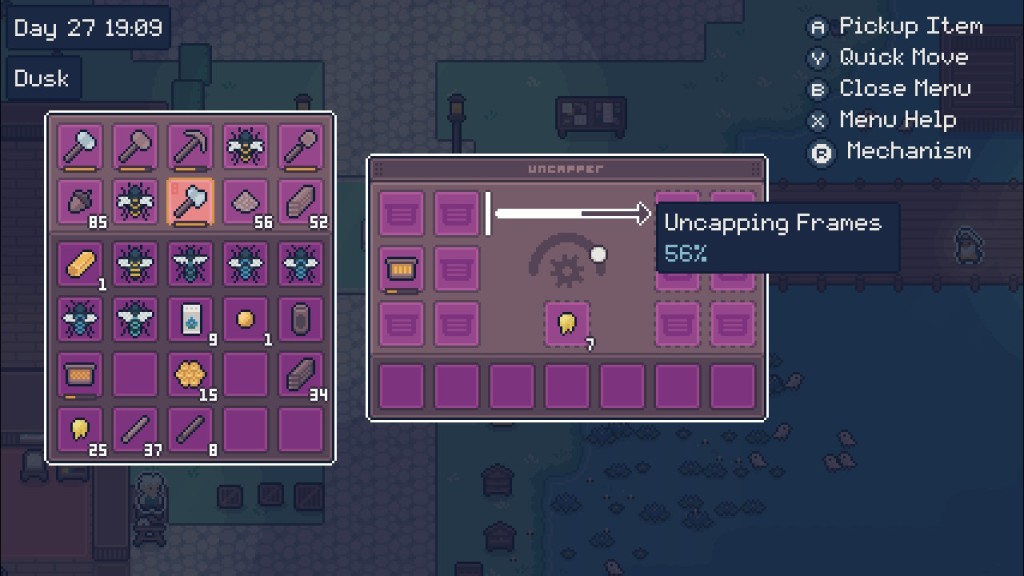
Bees will produce plain honeycombs for you in beehives, but if you want additional byproducts, you’ll need to craft frames to collect them. Your tools and these frames all have limited uses, so once they break you have to craft new ones. When the bees fill the frames placed in their apiary, they have to be placed in the uncapping bench and then the extractor to get byproducts like flower seeds or honey. Then you can produce the biggest money making item, Apicola, by combining water and honey in the Fermenter then bottling it.
There are a decent amount of items for you to craft or gather. One of the main resources used in crafting would be the wood you get from cutting down trees. (As this game is all about conservation efforts, you need to plant new trees to make up for what you’ve taken away.) Logs come from cutting down trees, then you use the Sawmill to turn logs into planks then poles. Logs, planks, and/or poles will be used in many crafting recipes – but wait! There’s more! Some crafting recipes need wood products that have been infused with resin obtained from trees. They really put a lot of work into the ideas for each piece of machinery and into crafting. It’s really neat that I could use many different ingredients originating from one tree, as well as the honey byproducts.
As you do your best to conserve and respect nature overall, the Encyclobeedia will let you know how you’re doing with the bee conservation efforts specifically. Each bee’s page will include a brief description of the bee species, any special byproducts they make, and their conservation status (“Thriving: This species is saved!”). Once you’ve managed to breed enough of a species, you can rehabeelitate them and release them to revitalize the population in nature! APICO has a great message and uses a decent amount of biology terms, mentioning concepts like dominant and recessive traits. The game is rated E for everyone, and I think it would be a fantastic educational tool that also happens to be pretty fun!
Please note that APICO does have a multiplayer mode that I was unable to experience without knowing other players’ hosting codes. Cross play can be enabled through this mode.
Switch it ON or Switch it OFF? APICO is a thoughtfully designed simulation game where you immerse yourself in the beekeeping process to bring back the bees to Port APICO. It can be a bit “grindy” in the process of building up funds and fulfilling the right conditions for crossbred bees. I felt a little lost sometimes in the later stages of the game. But other than that, I was very appreciative of the developer’s efforts in explaining the game’s mechanics through the in-game guidebook. I thought the art style was colorful and cute, and the soundtrack was quite pleasant to listen to as I managed my machinery and boosted the bee population. There’s a lot to do and many bees to save in this game. 8/10
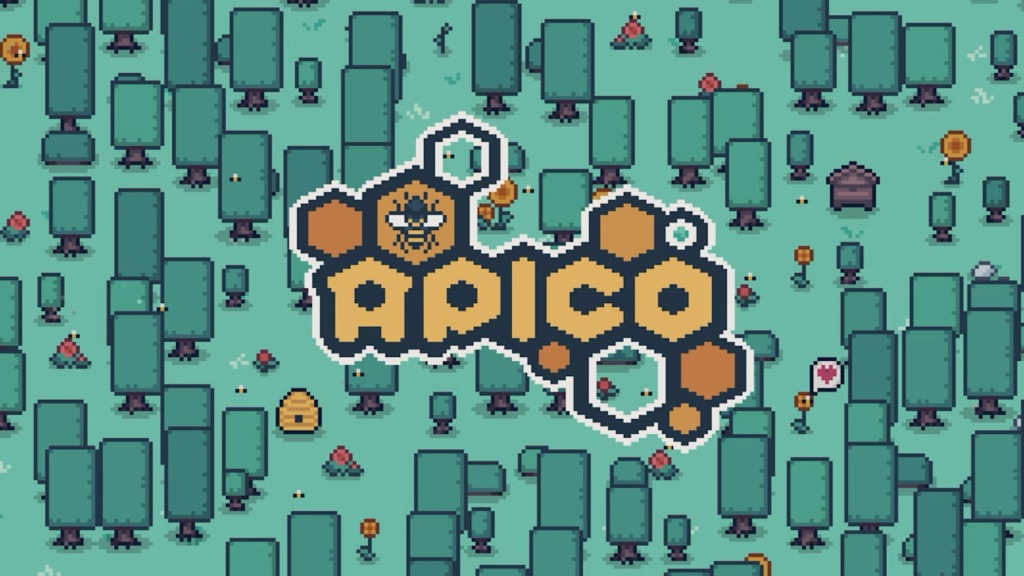
Leave a comment